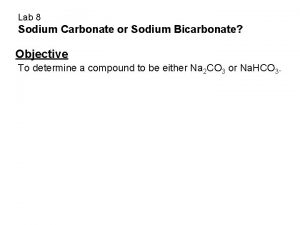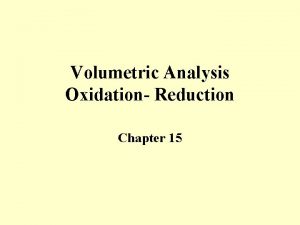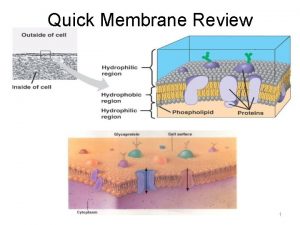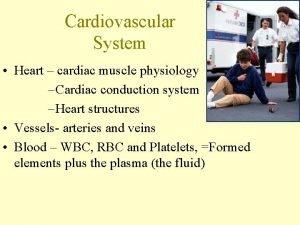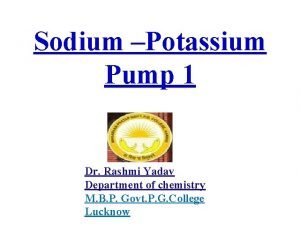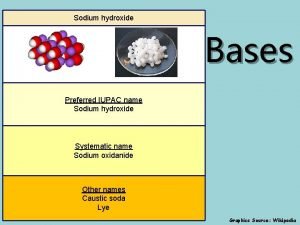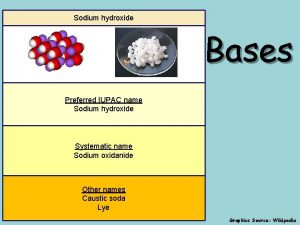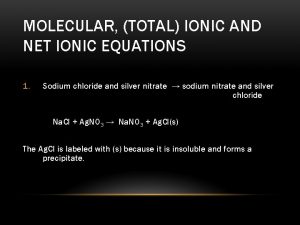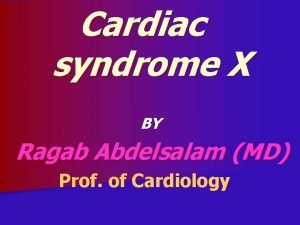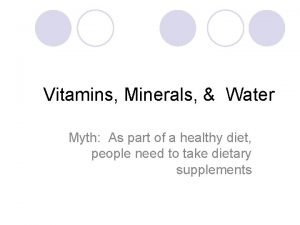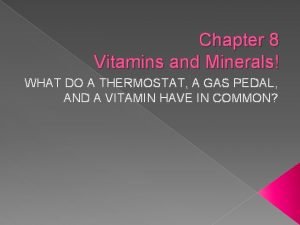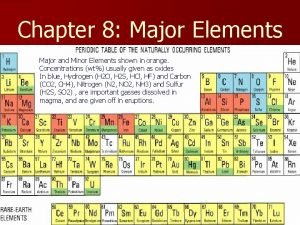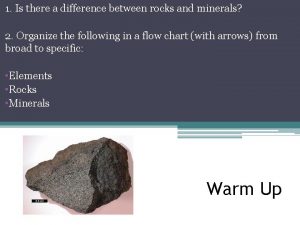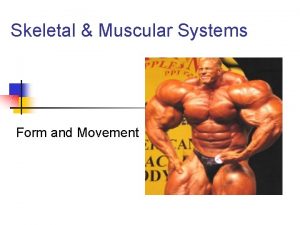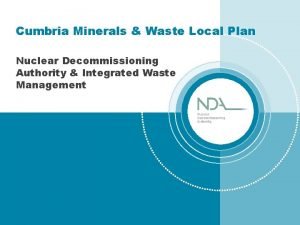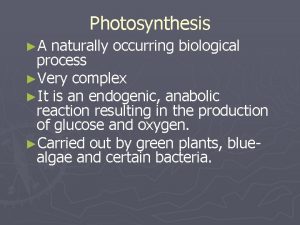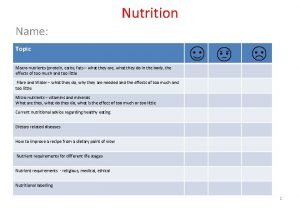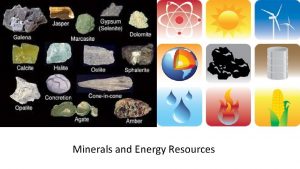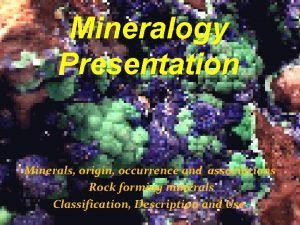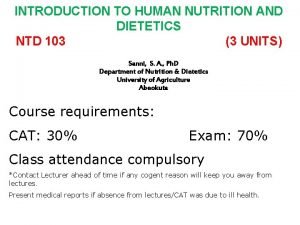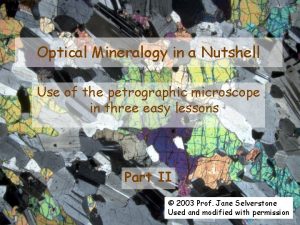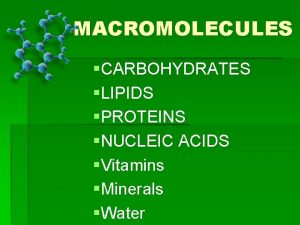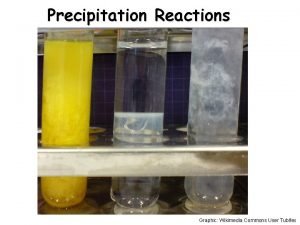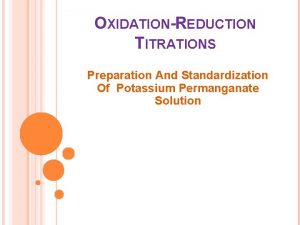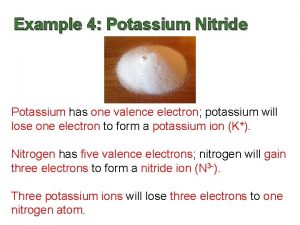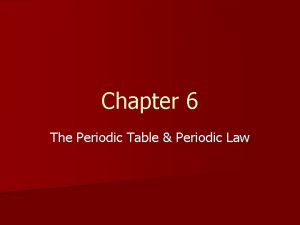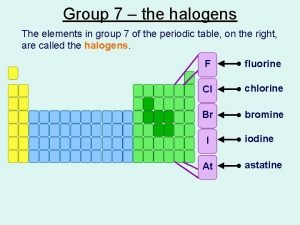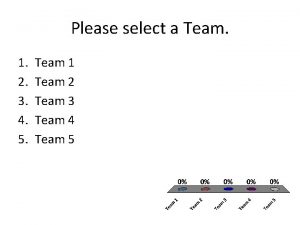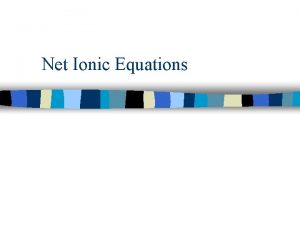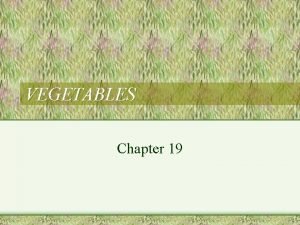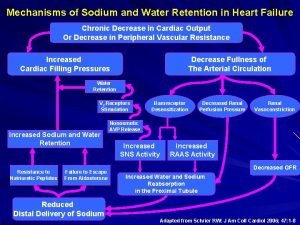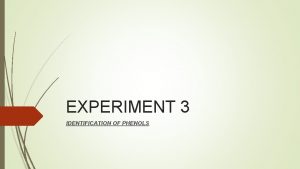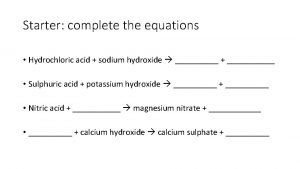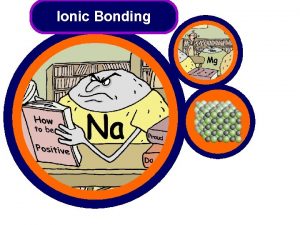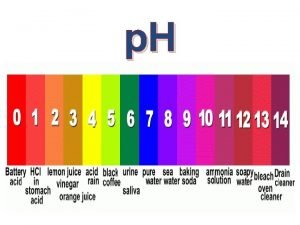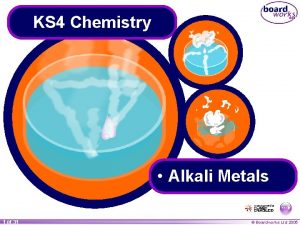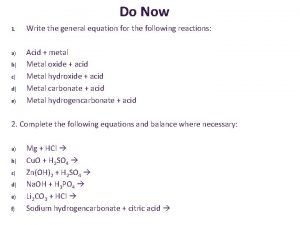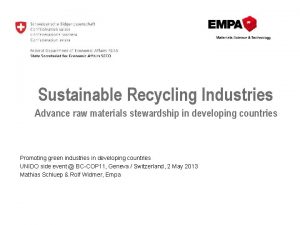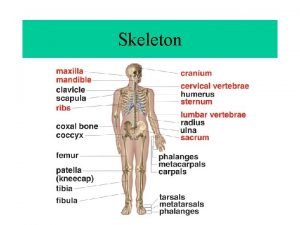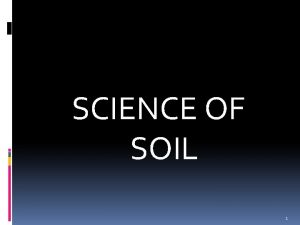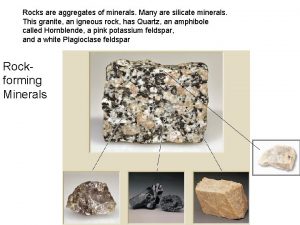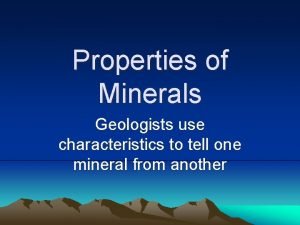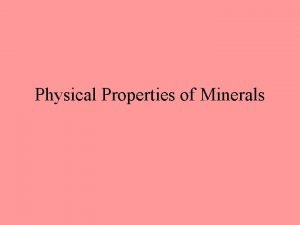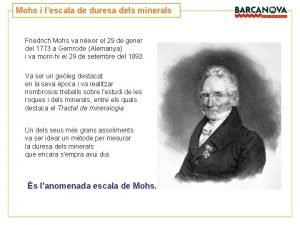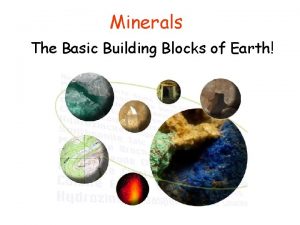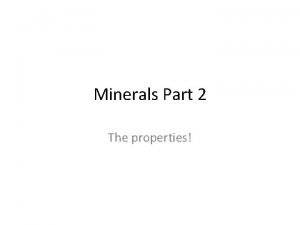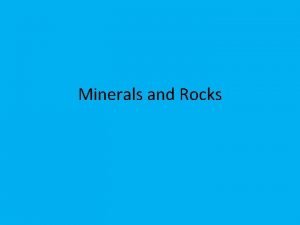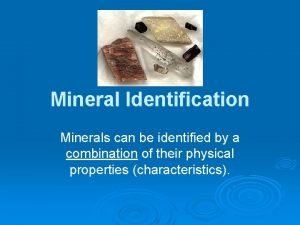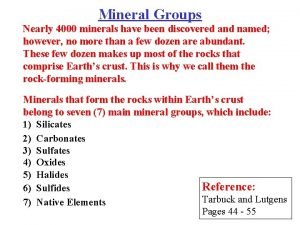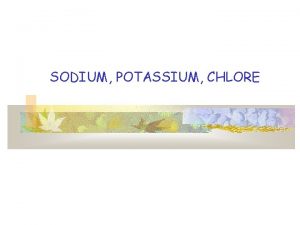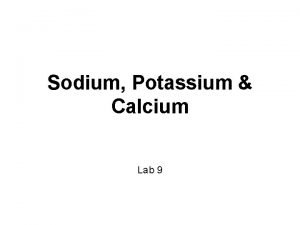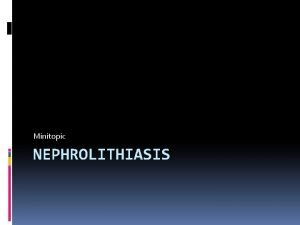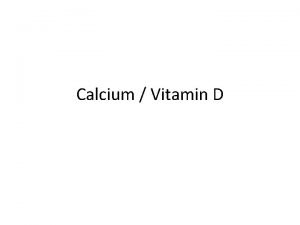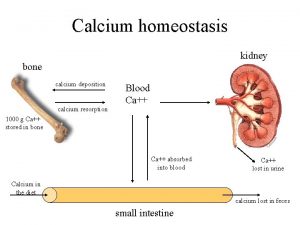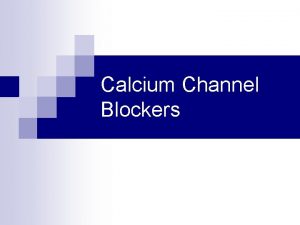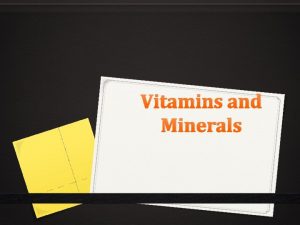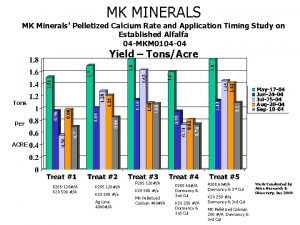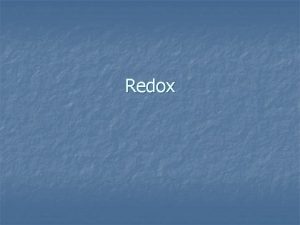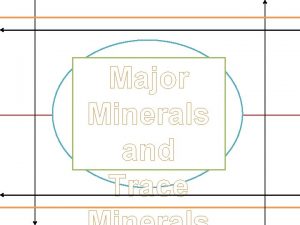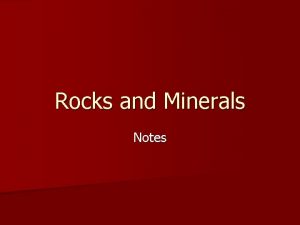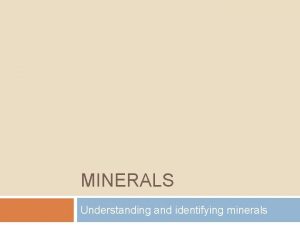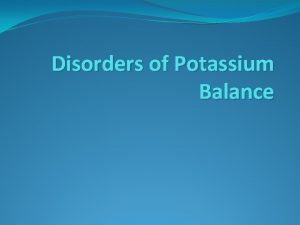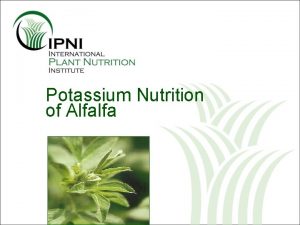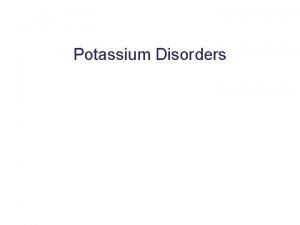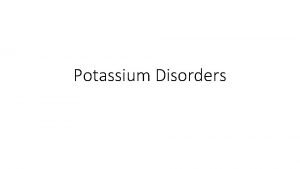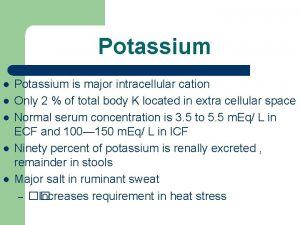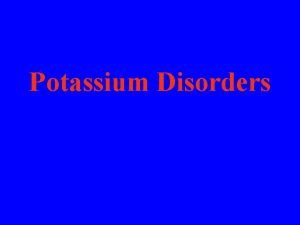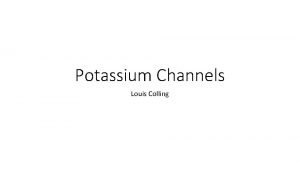Focus on Minerals Sodium and Potassium Calcium and















































































- Slides: 79

Focus on Minerals Sodium and Potassium Calcium and Vitamin D Iron

Minerals: Key Concepts About 20 are essential Minerals are single atoms that cannot be created or destroyed by any ordinary means These single atoms usually carry a charge, which makes them reactive Minerals are components of body structures and play key roles in the regulation of body processes

Minerals: Key Concepts Macrominerals needed in relatively large amounts 7 macrominerals Sodium RDA 2, 300 milligrams Calcium RDA 1, 000 mg for adults under 50 Microminerals needed in smaller amounts 9 microminerals Iron RDA for women postmenopause 8 mg Iodine RDA 150 mcg

Mineral Charges Charge allows minerals to combine with minerals of opposite charge to form stable compounds These become part of bones, teeth, cartilage, and other tissues In body fluids, charged minerals are a source of electrical power to stimulate muscles to contract and nerves to react Charge of minerals is related to many other functions helps maintain an adequate amount of water in the body assists in neutralizing body fluids when too acidic or basic minerals are components of proteins and enzymes

Charge Problems Minerals may combine with other substances in food and form highly stable compounds not easily absorbed Much of the calcium in spinach is bound to oxalic acid Zinc in whole-grain products is poorly absorbed because it is bound tightly to phytate Absorption of iron decreases by about 50% if tea or cola is consumed Iron binds with tannic acid in tea and colas

Hypertension aka High Blood Pressure How Sodium and Potassium Affect blood pressure

Table salt is sodium chloride, Na. Cl. It is 40% sodium by weight; one teaspoon of salt contains about 2300 milligrams of sodium Sodium Recommendation is to limit sodium chloride to one teaspoon a day from all sources– and even less for African Americans.

Sodium in the Body Sodium and potassium work together in the body to maintain normal water balance Both chemically attract water, to maintain an optimal level of water in and out of cells Water balance and cell functions are by a balance of sodium and potassium Body’s adaptive mechanisms provide a buffer against upsets in water balance due to high sodium intake– up to a point.

Blood Pressure Systolic blood pressure is highest at heartbeat and diastolic is when heart is relaxing between pulses Normal blood pressure is less than 120/80 mm of mercury Prehypertension is 120/80 -139/89 Hypertension is 140/90 mm. Hg and higher Several measurements are needed

Hypertension High blood pressure is a leading cause of cardiovascular disease. It accounts for twothirds of all strokes and half of heart disease. US Rates of Hypertension

Causes of Hypertension 10% of all cases of hypertension can be directly linked to a cause 90% with no identifiable cause: essential hypertension Risk factors for hypertension have been identified Dietary factors are the most important

Hypertension-Promoting Diet & Lifestyle (if you wanted to develop high blood pressure) Eat mostly processed foods high in sodium Eat more calories than you can use Drink alcohol beverages in excess Eat few dairy products or sources of calcium Eat few vegetables, fruits; avoid potassiumrich foods Enjoy plenty of foods high in saturated fat Avoid exercise

Ethnic Group

Epidemiological Studies In countries with low sodium intakes, rate of hypertension is low In countries with moderate sodium intakes, rate of hypertension is moderate…

Causes of Hypertension Not everyone is equally susceptible to highsalt diets People often develop salt-sensitivity before they develop hypertension. But over 50% of people with hypertension and 26% of people with normal blood pressure are salt sensitive

Salt Sensitivity Most of our population will develop high blood pressure as they age But when people reduce salt intake, they are likely to maintain normal blood pressure longer


Major Sources of Sodium in US Diet Processed foods Fresh foods Salt added at the table Salt added during cooking in the home 77% 12% 10% 3%

10 Foods responsible for over 40 % of people’s sodium intake Breads and rolls Luncheon meat such as deli ham or turkey Pizza & cheese Poultry Soups Pasta dishes with cheese, cream or meat sauces with salt added Meat dishes such as meat loaf Snack foods like potato chips, pretzels and popcorn.

100 calories instant grits 500 mg old fashioned grits 0 mg Fig. 23 -16, p. 22

Balance Sodium and Potassium High potassium intake helps relax blood vessels and excrete the sodium, so decreases blood pressure. We need more potassium than sodium each day! Americans average about 3, 300 mg of sodium per day But only about 2, 900 mg of potassium

High Potassium Foods Reduce Blood Pressure (RDA 4700 mg)

TO Avoid Hypertension Follow the DASH diet Even better at reducing blood pressure than a low salt diet!

Simplified DASH Diet 1. Have 1 small glass of fruit juice and 3 more servings of fruit every day— fresh, frozen or canned.

Simplified DASH Diet 2. Eat 4 servings of vegetables every day. French fries don't count! Sweet potatoes, broccoli, greens, carrots, tomatoes, tossed salad…

Simplified DASH Diet, cont. 3. Have 2 servings of nonfat or low-fat dairy products daily, including yogurt. Count soy beverage or other high-calcium beverages here, too.

Simplified DASH Diet, cont. 4. Limit red meat and saturated fats

Simplified DASH Diet, cont. 5. Limit sweets. Make fruits your main sweets and snacks.

Simplified DASH Diet, cont. 6. Use a salt substitute like "no-salt" lightly at the table (not in cooking—it gets bitter) YES NO!

Enjoy Foods Naturally Low in Sodium Learn to use spices, peppers, onions, garlic, and lemon juice for flavor A low sodium diet and the DASH diet are two separate ways to reduce your risk of hypertension— Or to treat it!

How Is Hypertension Treated? Lifestyle and diet changes, and medications Weight loss, smoking cessation, regular exercise DASH diet (Dietary Approaches to Treating Hypertension) Low sodium diet Low alcohol consumption

Learn One of These! Fig. 23 -17, p. 22

Blood Pressure Medications Prescribed when diet & lifestyle changes don't bring pressure down to normal. Still need to follow diet and lifestyle changes Side effects of various anti-hypertensive medications may include: excess urination, low blood potassium, weakness, fatigue, depression, confusion, erectile dysfunction, headache, edema However, some people have no side effects from medication.

IN THE UNITED STATES Half the people who have hypertension don’t know it Half of those who know it, aren’t getting treatment Half of those getting treatment, aren’t treated adequately to control BP Many unnecessary strokes, heart attacks, and early deaths

Farm Stand: Good source of Low Sodium, High Potassium, And Low Cost Foods

CALCIUM AND VITAMIN D

Calcium in the diet is absorbed with the help of Vitamin D either in the blood or in food 99% of the 3 lbs of calcium in the body is located in bones and teeth 1% is found in blood and other body fluids, where it has many important roles Calcium’s noted function is in bone formation and osteoporosis prevention

Bones 206 bones in our body are slightly flexible living tissues infiltrated by blood vessels, nerves, and cells Solid parts are networks of protein fibers embedded with mineral crystals Calcium is abundant in bone, along with magnesium and other minerals Teeth are like bone plus covering called enamel Enamel protects teeth from acids and wear

Bone Formation Bones develop and mineralize throughout the first 3 decades of life Every day, cells called osteoclasts break bone down Cells called osteoblasts repair damage by forming new, healthy bone. Called “remodeling”

Inadequate calcium Bangladesh

Treating Rickets

Building Strong Bones Adequate calcium and vitamin D Regular exercise, especially weight-bearing and muscle strengthening exercise. Adequate vitamin K, found in green, leafy vegetables

What’s the RDA–and how to get it Calcium 1, 000 mg/day for those age 19 to 50 1, 200 mg/day for women over 50 and men over 70 Vitamin D Sunshine Fortified foods a multivitamin that supplies 800 to 2, 000 IU of vitamin D per day

Sources of Calcium Dairy Milk Fortified w/ Ca and Vit D Yogurt Cheese Cream, icecream Non Dairy Soy beverages Fortified w/ Ca and Vit D Tofu Fish with bones i. e. sardines Dark greens Legumes

Remodeling Bones During remodeling, old protein matrix is replaced and remineralized Total bone replacement every 10 years Up to about age 30, osteoblasts build more bone than is lost Peak bone density reached by age 30

Bone Remodeling After that, bone mineral content no longer increases The higher the peak bone mass, the less likely it is that osteoporosis will develop After age 50, blood levels of estrogen and testosterone decrease Bones demineralize as osteoclasts “outperform” osteoblasts Insufficient calcium is one cause of …

Osteoporosis Over 20 million adults in the United States have osteoporosis About half of all women and about one third of men will have an osteoporotic fracture during their lives

Osteoporosis 1. 5 million suffer broken bones each year due to the disease 300, 000 hip fractures/year with a 20% death rate within one year Many permanent disabilities

Causes of Osteoporosis Related to genetics, race, sex, diet, exercise, childbearing Develops later in Men African Americans Women who have had several children Typically, by the time a woman is 70 her bones are 30 to 40% less dense

Early Osteoporosis Who’s at most risk? Asians and Caucasians Women, especially childless Small-boned, thin people Smokers Sedentary people And, of course, those with poor diet

Build and Maintain Bones Vitamin D increases calcium absorption and the deposition of calcium into bone Few foods naturally have Vitamin D Supplements, fortified foods, or sunshine can provide Vitamin D In much of the world, exposing hands and face to sunshine for 15 to 30 minutes produces a day’s supply of vitamin D

Build and Maintain Bones After age 50, preserving bone density requires adequate calcium and vitamin D Regular exercise, especially weight-bearing and muscle strengthening exercise. Adequate vitamin K (source: dark greens) RDA for women is 90 mcg Data from Nurses’ Health Study suggests that over 110 mcg is better for bone health

Prevent Osteoporosis Avoid excessive preformed vitamin A Retinol May increase number of osteoclasts Caffeine may increase calcium loss in urine Phosphoric acid (in cola) may increase calcium loss also High protein diet may increase calcium loss

Osteoporosis Treatment Calcium supplements or intakes to 10001500 milligrams per day Vitamin D supplements (1000 IU or more) Other medications (phosphomax, etc) Weight-bearing exercise (walking, tennis) stimulates bone growth and decreases progression of osteoporosis

Where do You get your Calcium? To meet recommended level of intake choose 2 or 3 foods rich in calcium every day Calcium absorption decreases with age and Vitamin D inadequacy

Too Much Calcium You can consume too much calcium Supplement doses exceeding 2. 5 grams (2500 mg) per day produce drowsiness, constipation, and cause calcium to deposit in tissues

New Vitamin D Research Bone and Muscle Strength Heart Disease Cancer Immune Function Multiple Sclerosis Type 1 Diabetes Flu and Colds Risk of Premature Death Read more at www. hsph. harvard. edu/nutritionsource/ vitamin-d/

IRON BASICS

Charge Problems Minerals may combine with other substances in food and form highly stable compounds not easily absorbed Much of the calcium in spinach is bound to oxalic acid Zinc in whole-grain products is poorly absorbed because it is bound tightly to phytate Absorption of iron decreases by about 50% if tea or cola is consumed Iron binds with tannic acid in tea and colas

Iron Most iron is found in hemoglobin Hundreds of hemoglobin molecules are in each red blood cell Blood cells are made in bone marrow Small amounts of iron are present in myoglobin in other cells

Iron in Hemoglobin Iron readily combines with oxygen Iron in hemoglobin attaches to oxygen in the lungs Hemoglobin releases oxygen from iron to cells Free iron picks up carbon dioxide from cells Blood returns to lungs, carbon dioxide is released Free iron combines with oxygen The cycle continues

Hemoglobin Structure Four polypeptide strands Each has a Heme ring, in red, which contains the iron. Oxygen is bound and then released by the iron

Iron in Myoglobin Iron in myoglobin traps oxygen, stores it, and releases it as needed for energy for muscle activity Myoglobin boosts oxygen available to muscles These functions require supply of iron that is sufficient

Iron Deficiency 1/3 of people in world are iron deficient Iron deficiency affects mostly children and women with high need and low consumption

In Developing Countries Half of pregnant woman are estimated to be anemic. Anemia contributes to 20% of all maternal deaths. About 40% of preschool children are estimated to be anemic.

Iron Deficiency Develops in people who have lost blood, including women with heavy menses (slow bleeding to death) Can develop with chronic use of antacids, which can impair iron absorption

Consequences People with iron deficiency are weak and tired have short attention span have poor appetite are susceptible to infection become irritable easily

Iron-deficiency anemia Develops with additional symptoms People with iron-deficiency anemia look pale are easily exhausted have rapid heart rates Iron-deficiency anemia in infants and young children is related to lasting retardation in mental development

Getting Enough Iron Sources of iron: heme in meat, iron in plant foods Iron in fortified foods and supplements Foods cooked in iron and steel pans Enough iron is 8 milligrams for men and postmenopausal women 18 milligrams per day for women under 50 Women have to consume about 2500 calories per day of good foods to obtain 15 milligrams of iron

Treating Deficiency Supplements Ferrous sulfate (Feosol, Slow Fe) Ferrous gluconate (Fergon) Ferrous fumarate (Femiron, Feostat) Preventing Deficiency maybe with a lucky fish Read about the www. luckyironfish. com/


Getting Enough Iron Most iron in plants and eggs tightly bound A three-ounce hamburger and a cup of asparagus both contain three milligrams of iron 20 times more iron is absorbed from hamburger than from the asparagus Transferrin in intestinal mucosa regulates iron absorption increased by low levels of iron stores; when iron stores high, less iron absorbed Such regulation of iron absorption provides some protection against iron deficiency and overdose

Cross-section of Digestive Tract

Overdosing on Iron Excess iron absorbed into the body cannot be easily excreted Iron is deposited in the liver, pancreas, and heart Iron excess results in liver disease, diabetes, and heart failure People at risk of iron toxicity: Heavy drinkers (increased absorption of iron) Very high iron intake or one time overdose Genetic disorder

Hereditary Hemochromatosis Most common genetic disease in whites Nonspecific early symptoms: Fatigue Weight loss Abdominal pain Weakness Joint Pain As Iron Accumulates: Arthritis Diabetes Grey or bronze tone to skin Cirrhosis of the liver Liver cancer Heart failure

Frequency & Treatment North & western European ancestry: 0. 5% homozygous, 10% carriers Mexican Americans. 03% homozygous African Americans. 06% Occurrence of symptoms Earlier for men than women Detection & Prevention Treatment: Phlebotomy

Overdosing on Iron Supplements Can cause rapid tissue damage, seizures, coma & heart failure Victims often young children Lethal dose of iron for a two-year-old child is about three grams, amount in 25 120 mgm pills 40 children’s multivitamins with iron could seriously injure a child

Iron Overdoses, 1990's In 1991, 10 children died from iron overdoses. Government required warning labels and childproof bottles 1998 2500 children under 6 overdosed on iron, 730 required treatment, 0 deaths Between 1999 -2002, only one child death Childproof containers and careful parents protect children

 Sodium bicarbonate to sodium carbonate equation
Sodium bicarbonate to sodium carbonate equation Redox volumetric analysis
Redox volumetric analysis Sodium chloride and sodium carbonate
Sodium chloride and sodium carbonate Sodium hypochlorite and sodium hydroxide
Sodium hypochlorite and sodium hydroxide Membran sel
Membran sel Saltatory conduction animation
Saltatory conduction animation 3 sodium out 2 potassium in
3 sodium out 2 potassium in Sodium potassium pump animation
Sodium potassium pump animation Image search
Image search Metals vs nonmetals
Metals vs nonmetals Bioinorganic chemistry introduction
Bioinorganic chemistry introduction What is the iupac name of the base naoh?
What is the iupac name of the base naoh? Honh2 dissociation equation
Honh2 dissociation equation Silver chloride ionic formula
Silver chloride ionic formula Asymmetric dimethylarginine
Asymmetric dimethylarginine Porter's competitive strategies
Porter's competitive strategies Cost leadership strategy
Cost leadership strategy Focus on form vs focus on forms
Focus on form vs focus on forms Actor focus vs object focus
Actor focus vs object focus Minerals and their functions sources and deficiency chart
Minerals and their functions sources and deficiency chart Types of rocks
Types of rocks Why is bowen's reaction series important
Why is bowen's reaction series important Chapter 8 vitamins and minerals
Chapter 8 vitamins and minerals Major elements
Major elements Difference between rocks and minerals
Difference between rocks and minerals Type of rocks concept map
Type of rocks concept map Suzanna socked me sunday poem
Suzanna socked me sunday poem Absorbs water and minerals
Absorbs water and minerals Difference between rock and stone
Difference between rock and stone Padma mines and minerals corporation
Padma mines and minerals corporation Stores minerals and anchors muscles
Stores minerals and anchors muscles Cumbria minerals and waste local plan
Cumbria minerals and waste local plan Minerals and fuels
Minerals and fuels Minerals and fuels
Minerals and fuels Vitamins sources functions and deficiency chart
Vitamins sources functions and deficiency chart Minerals and fuels
Minerals and fuels Prepare chart for vitamins and minerals
Prepare chart for vitamins and minerals Prepare chart for vitamins and minerals
Prepare chart for vitamins and minerals Rock type
Rock type Isogyres mineralogy
Isogyres mineralogy Site:slidetodoc.com
Site:slidetodoc.com Solubility table
Solubility table Kmno4 uses
Kmno4 uses Valence electrons for potassium
Valence electrons for potassium Potassium bromine and krypton
Potassium bromine and krypton Potassium chloride + silver nitrate
Potassium chloride + silver nitrate Chlorine gas + potassium bromide
Chlorine gas + potassium bromide Group 7 elements
Group 7 elements Copper sulfate and potassium iodide
Copper sulfate and potassium iodide Chlorine gas and potassium bromide
Chlorine gas and potassium bromide Hydrochloric acid and potassium hydroxide
Hydrochloric acid and potassium hydroxide Net ionic reaction
Net ionic reaction It is higher in sodium and possibly mushy in texture
It is higher in sodium and possibly mushy in texture Insulin and sodium retention
Insulin and sodium retention Pathophysiology of sodium and water retention
Pathophysiology of sodium and water retention Fecl3 test
Fecl3 test Hydrochloric acid and sodium hydroxide
Hydrochloric acid and sodium hydroxide Saponification of ethyl acetate and sodium hydroxide
Saponification of ethyl acetate and sodium hydroxide Magnesium ion charge
Magnesium ion charge What is the percent of iodine in ointment
What is the percent of iodine in ointment I intro
I intro Spectator ions
Spectator ions Sodium carbonate reacts with hydrochloric acid
Sodium carbonate reacts with hydrochloric acid Double replacement neutralization
Double replacement neutralization Lithium react with oxygen equation
Lithium react with oxygen equation Nitric acid+calcium carbonate
Nitric acid+calcium carbonate Streak of minerals
Streak of minerals Conflict minerals
Conflict minerals Storage of minerals
Storage of minerals Semi circular bunds
Semi circular bunds Quartzite rock cycle
Quartzite rock cycle Rocks are aggregates of minerals
Rocks are aggregates of minerals Cleavage of chalk
Cleavage of chalk Color properties of minerals
Color properties of minerals Pirita duresa
Pirita duresa Luster
Luster Fracture minerals
Fracture minerals Characteristic of minerals
Characteristic of minerals Define luster in minerals
Define luster in minerals Nearly 4 000 minerals have been named
Nearly 4 000 minerals have been named
